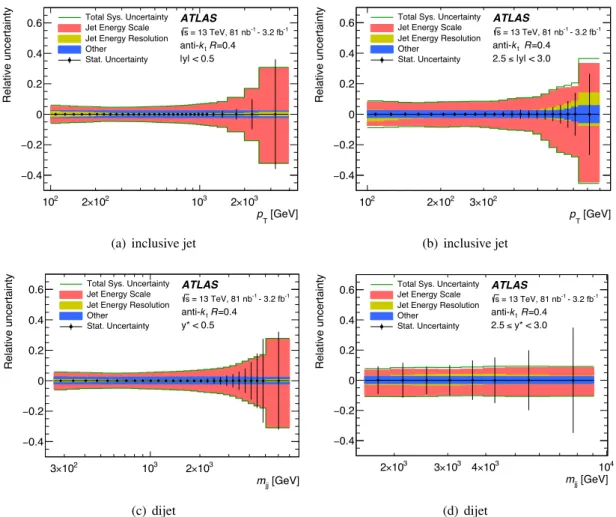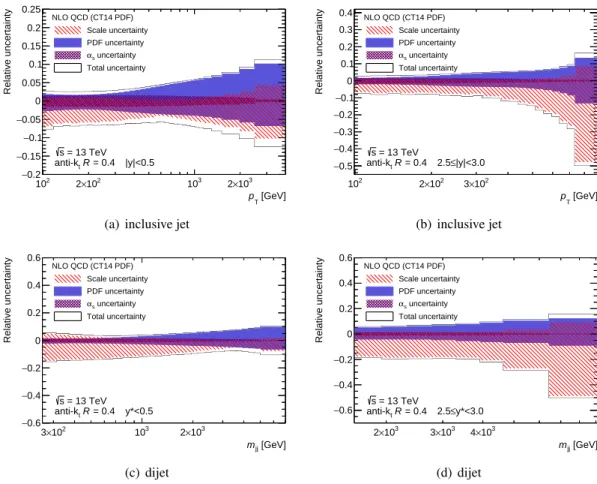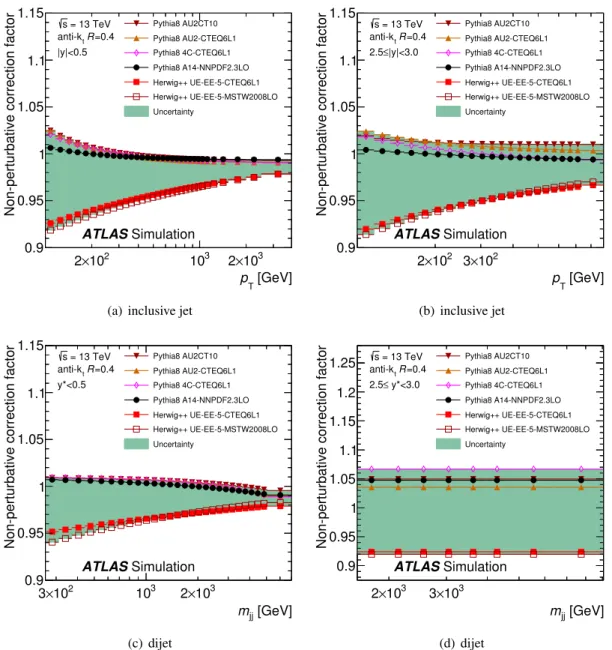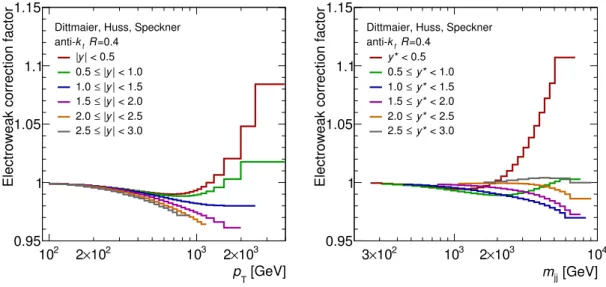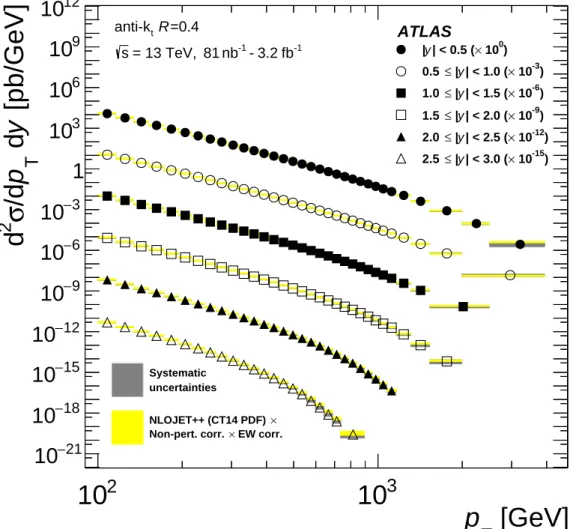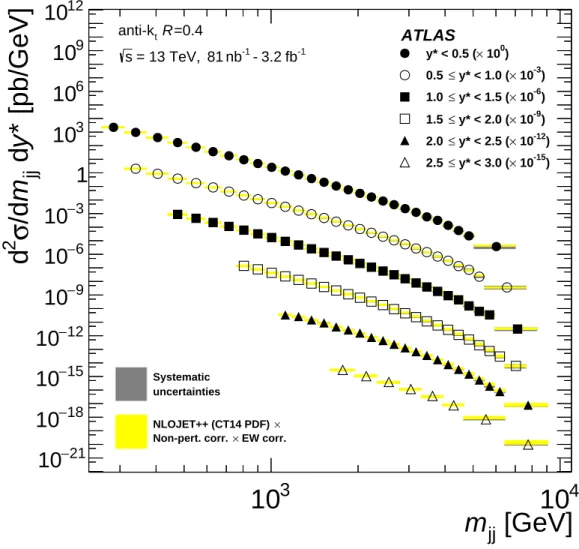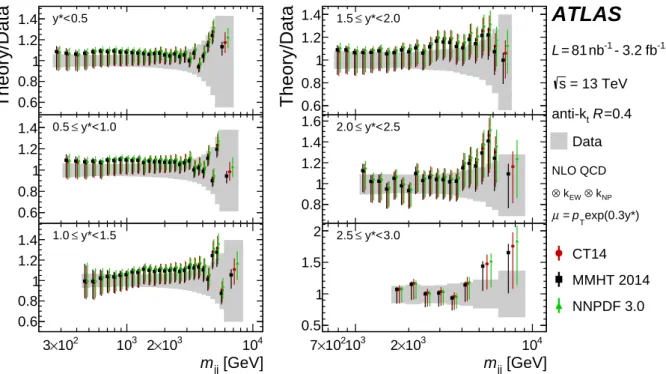EUROPEAN ORGANISATION FOR NUCLEAR RESEARCH (CERN)
JHEP 05 (2018) 195
DOI:https://doi.org/10.1007/JHEP05(2018)195
CERN-EP-2017-157 19th July 2018
Measurement of inclusive jet and dijet cross-sections in protonproton collisions at√
s = 13 TeV with the ATLAS detector
The ATLAS Collaboration
Inclusive jet and dijet cross-sections are measured in protonproton collisions at a centre- of-mass energy of 13 TeV. The measurement uses a dataset with an integrated luminosity of 3.2 fb−1 recorded in 2015 with the ATLAS detector at the Large Hadron Collider. Jets are identified using the anti-ktalgorithm with a radius parameter value ofR=0.4. The inclusive jet cross-sections are measured double-differentially as a function of the jet transverse mo- mentum, covering the range from 100 GeV to 3.5 TeV, and the absolute jet rapidity up to
|y|=3. The double-differential dijet production cross-sections are presented as a function of the dijet mass, covering the range from 300 GeV to 9 TeV, and the half absolute rapidity sep- aration between the two leading jets within|y| < 3,y∗, up toy∗= 3. Next-to-leading-order, and next-to-next-to-leading-order for the inclusive jet measurement, perturbative QCD calcu- lations corrected for non-perturbative and electroweak effects are compared to the measured cross-sections.
c
2018 CERN for the benefit of the ATLAS Collaboration.
arXiv:1711.02692v2 [hep-ex] 18 Jul 2018
Contents
1 Introduction 3
2 ATLAS detector 4
3 Cross-section definitions 4
4 Dataset and Monte Carlo simulations 5
5 Event and jet selection 6
6 Jet energy calibration and resolution 6
6.1 Jet reconstruction 6
6.2 Jet energy calibration 7
6.3 Jet energy scale uncertainties 8
6.4 Jet energy resolution and its uncertainties 8
6.5 Jet angular resolution and its uncertainties 9
7 Unfolding of detector effects 9
8 Propagation of the uncertainties to the cross-sections 10
9 Theoretical predictions 13
9.1 Next-to-leading-order pQCD calculations 13
9.2 Non-perturbative corrections 13
9.3 Electroweak corrections 15
9.4 Next-to-next-to-leading-order pQCD calculations 16
10 Results 17
11 Conclusion 25
1 Introduction
Precise measurements of jet cross-sections are crucial in understanding physics at hadron colliders. In quantum chromodynamics (QCD), jets are interpreted as resulting from the fragmentation of quarks and gluons produced in a short-distance scattering process. Jet cross-sections provide valuable information about the strong coupling constant,αs, and the structure of the proton. Also, inclusive jet and dijet events represent a background to many other processes at hadron colliders. The predictive power of fixed-order QCD calculations is therefore relevant in many searches for new physics.
Inclusive jet production cross-sections have been measured in collisions of hadrons at the Sp¯pS and Tevat- ron colliders at various centre-of-mass energies. The latest and most precise results at √
s=1.96 TeV are detailed in Refs. [1,2]. At the Large Hadron Collider (LHC) [3] at CERN, the ALICE, ATLAS and CMS collaborations have measured inclusive jet cross-sections in protonproton collisions at centre-of-mass energies of √
s = 2.76 TeV [4–6] and √
s = 7 TeV [7–10]. Recently, the ATLAS and CMS collabora- tions have measured the inclusive jet cross-sections at √
s = 8 TeV [11,12], and the CMS Collaboration also at √
s = 13 TeV [13]. Dijet production at the LHC has been measured by the ATLAS and CMS collaborations at a centre-of-mass energy of √
s = 7 TeV [7,14], and also by the CMS Collaboration at
√s=8 TeV [15].
This paper presents measurements of the inclusive jet and dijet cross-sections in protonproton collisions at √
s = 13 TeV centre-of-mass energy by the ATLAS Collaboration at the LHC, using data collected in 2015 and corresponding to an integrated luminosity of 3.2 fb−1. The inclusive jet cross-sections are measured double-differentially as a function of the jet transverse momentum,pT, and absolute jet rapidity,
|y|.1 In addition, the double-differential dijet production cross-sections are presented as a function of the invariant mass of the dijet system,mj j, and as a function of half the absolute rapidity separation between the two highest-pTjets satisfying|y|<3, denotedy∗.2Jets are reconstructed using the anti-ktjet clustering algorithm [16] with a radius parameter value ofR= 0.4. The measurements cover the kinematic region of 100 GeV< pT<3.5 TeV and|y|<3 for the inclusive jet cross-section, and of 300 GeV<mj j<9 TeV andy∗<3 for the dijet cross-section.
Next-to-leading-order (NLO) perturbative QCD (pQCD) predictions calculated using several parton dis- tribution function (PDF) sets, corrected for electroweak and non-perturbative effects, are quantitatively compared to the measurement results. In addition, the inclusive jet cross-sections are compared to the recently published complete next-to-next-to-leading-order (NNLO) pQCD calculation [17,18].
1The rapidity is defined asy=0.5×ln[(E+pz)/(E−pz)], whereEdenotes the energy andpzis the component of the momentum along the beam direction.
2The variabley∗ is defined as|y1−y2|/2, where the subscripts 1,2 label the highest and second highest-pT jet in the event satisfying|y|<3.0, respectively. This quantity is invariant under a Lorentz boost along thez-direction and is equal to the absolute rapidity of each jet in the dijet rest frame.
2 ATLAS detector
The ATLAS experiment [19,20] at the LHC is a multi-purpose particle detector with a forward-backward symmetric cylindrical geometry and a near 4πcoverage in solid angle.3 It consists of an inner track- ing detector, electromagnetic and hadron calorimeters, and a muon spectrometer. The inner tracking detector covers the pseudorapidity range|η| < 2.5 and is used to reconstruct tracks and vertices. It con- sists of silicon pixel, silicon microstrip, and transition radiation tracking detectors, surrounded by a thin superconducting solenoid providing a 2 T axial magnetic field. Lead/liquid-argon (LAr) sampling calor- imeters provide electromagnetic (EM) energy measurements with high granularity. They consist of a barrel (|η| < 1.475) and two endcap (1.375 ≤ |η| < 3.2) regions. The hadron calorimeters are divided into five distinct regions: a barrel region (|η| < 0.8), two extended barrel regions (0.8 ≤ |η| < 1.7) and two endcap regions (1.5 ≤ |η| < 3.2). The barrel and extended barrel regions are instrumented with steel/scintillator tile calorimeters. The endcap regions are instrumented with LAr calorimeters for both the EM and hadronic energy measurements. The ATLAS calorimeters have very high lateral granularity and several samplings in depth over|η| < 3.2. The muon spectrometer surrounds the calorimeters and features three large air-core toroid superconducting magnets with eight coils each. The field integral of the toroids ranges between 2.0 and 6.0 Tm across most of the detector. It includes a system of precision tracking chambers for track measurement in the principal bending direction and fast detectors for trig- gering and measurement of the muon coordinate in the direction orthogonal to that determined by the precision-tracking chambers. A two-level trigger system is used to select events. The first-level trigger is implemented in hardware and uses a subset of the detector information. This is followed by the high- level trigger system [21], which is software-based and can run the offline reconstruction and calibration software, further reducing the event rate to an average of 1 kHz.
3 Cross-section definitions
The jet cross-sections are determined for so-called particle jets. These jets are built at the event generator level from stable particles, i.e. those fulfillingcτ >10 mm, whereτis the proper lifetime. This definition includes muons and neutrinos. Jets are identified using the anti-kt jet algorithm [16] as implemented in the FastJet [22] package with radius parameterR=0.4. The use of the anti-ktalgorithm is well motivated since it is infrared- and collinear-safe, and produces geometrically well-defined (“cone-like”) jets.
Inclusive jet double-differential cross-sections are measured as a function of jetpTin six equal-size bins of the absolute jet rapidity,|y|. Only jets in the kinematic rangepT>100 GeV and|y|<3.0 are considered, to ensure that the jet energy scale is well understood, as described in Section6. The inclusive jet production cross-section can be expressed as a ratio of the number of jets in data after correcting for detector effects, Njets, to the integrated luminosity of the data,L, in a given interval of momentum and rapidity,∆pT and
∆yrespectively:
d2σ
dpTdy = Njets L∆pT∆y.
3ATLAS uses a right-handed coordinate system with its origin at the nominal interaction point (IP) in the centre of the detector and thez-axis along the beam pipe. The x-axis points from the IP to the centre of the LHC ring, and they-axis points upward. Cylindrical coordinates (r, φ) are used in the transverse plane,φbeing the azimuthal angle around thez-axis. The pseudorapidity is defined in terms of the polar angleθasη=−ln tan(θ/2).
The dijet double-differential cross-section is measured as a function of the invariant mass of the dijet system,mj j, in six equal-size bins ofy∗, for events with at least two jets withpT >75 GeV and|y|<3.0.
In addition, the scalar sum of thepTof the first and second leading jets,HT,2= pT1+ pT2, is required to be above 200 GeV. This requirement avoids instabilities in the NLO cross-section calculations due to the symmetricpTrequirement applied to the leading and sub-leading jets [23,24].
The dijet production cross-section is calculated as the ratio of the number of dijet events after correcting for detector effects,Ndijet, to the integrated luminosity of the data, in a given interval of the invariant mass andy∗,∆mj jand∆y∗respectively:
d2σ
dmj jdy∗ = Ndijet L∆mj j∆y∗.
TheHT,2andpTselections on the two leading jets determine the lower edge of the mass range in eachy∗ bin. ThepT(mj j) binning is chosen according to the detectorpT(mj j) resolution, such that the bin width is approximately twice the pT (mj j) resolution, with the exception of the highest pT (mj j) bins in each rapidity (y∗) range where the bin width is enlarged to avoid large statistical fluctuations and non-Gaussian statistical uncertainties due to a low number of entries per bin; as predicted by a MC simulation (see Section4).
4 Dataset and Monte Carlo simulations
The measurements use protonproton collision data at a centre-of-mass energy of √
s=13 TeV collected by the ATLAS detector during the 2015 data-taking period of the LHC. The LHC beams were operated with proton bunches organised in “bunch trains”, with a bunch spacing of 25 ns. The integrated collected luminosity is 3.2 fb−1with an uncertainty of 2.1%. The uncertainty in the luminosity is derived following a methodology similar to that detailed in Ref. [25], from a calibration of the luminosity scale using xy beam-separation scans performed in August 2015.
Simulated jet events were produced using three different Monte Carlo event generators for comparisons to data and to derive corrections. The Pythia8 program (version 8.186 [26]) was used for the baseline comparisons, the deconvolution of detector effects and the propagation of systematic uncertainties. It uses LO pQCD matrix elements for 2→2 processes, along with a leading-logarithmic (LL) pT-ordered parton shower [27] including photon radiation, underlying event4 simulation with multiple parton inter- actions [28], and hadronisation with the Lund string model [29]. The samples were created using a set of tuned parameters called the A14 tune [30] and the NNPDF2.3LO [31] LO PDF set. The EvtGen 1.2.0 program [32] was used to model bottom and charm hadron decays. NLO samples of simulated events were produced using Powheg[24, 33] and showered with Pythia8 for systematic studies as discussed in Section6.3, and for optimising bin widths. The A14 tune and the CT10 [34] PDF set were used. For the evaluation of non-perturbative effects, the Pythia8 and Herwig++[35] (v2.7.1 [36]) event generators were also employed as described in Section9.2.
In all the samples, the effects of multiple protonproton interactions in the same and neighbouring bunch crossings (pile-up) were included by overlaying inelastic minimum-bias events generated with Pythia8.
The generated events were further weighted to reproduce the observed distribution of the average number
4The term underlying event is used to mean particles produced in the same protonproton collision, but not originating from the primary hard partonic scatter or its products.
of collisions per bunch crossing in data. The stable particles from the generated events were passed through the ATLAS detector simulation [37] based on Geant4 [38] and were reconstructed with the same version of the ATLAS software as was used to process the data.
5 Event and jet selection
A suite of single-jet triggers [21] with thresholds varying from 55 GeV to 360 GeV are used to record events with at least one jet with transverse energy,ET, above the threshold in the region|η|<3.2. To keep the trigger rate to an acceptable level, the triggers with lower ET thresholds are prescaled by recording only a predefined fraction of events. The highest-threshold trigger accepts all events passing the threshold.
The effective luminosities range from 81 nb−1 for 75 < pT < 100 GeV, where the trigger prescaling is largest, to 3.2 fb−1for pT>442 GeV, where an unprescaled trigger is used.
ApT-dependent trigger strategy is adopted in order to optimise the statistical power of the measurement.
In the inclusive jet measurement, each pT bin requires the trigger with the lowest prescale (i.e. with highest effective luminosity) that is fully efficient in that range. Due to the high prescale factors, trigger efficiencies are studied offline in data as a function of pT and rapidity by emulating the online trigger decision. The efficiency for jets in a given pT range is obtained as the fraction of those that pass the emulated trigger in an unbiased sample obtained by requiring at least one online jet passing the first-level trigger withET > 15 GeV. The trigger efficiency is always larger than 99.9% in thepT range where it is considered.
The trigger strategy for the dijet measurement is slightly different to account for different prescale com- binations for dijet events in a given (mj j, y∗) bin, which can be accepted by up to two jet triggers depending on the transverse momenta and pseudorapidities of the leading and sub-leading jets. Each pairing of trig- gers has a unique corresponding luminosity, which is used to calculate the differential cross section for that pairing. The separate cross sections from all pairings are then summed to obtain the final measure- ment. This strategy is described in detail in Ref. [39]. It was carefully validated in the previous dijet analysis [7] using dedicated simulation samples containing a complete set of prescaled triggers, similar to those used in this measurement.
Events are required to have at least one reconstructed vertex with at least two associated well-reconstructed tracks. The vertex maximisingP
p2T, where the sum is performed over the associated tracks, is chosen as the primary vertex. Quality criteria are applied to reject events with jets from beam-induced background due to proton losses upstream of the interaction point, cosmic-ray air showers overlapping with collision events and calorimeter noise from large-scale coherent noise or isolated pathological cells. These jet cleaning criteria are described in Ref. [40].
6 Jet energy calibration and resolution
6.1 Jet reconstruction
The input objects to the jet algorithm are three-dimensional topological clusters (topoclusters) [41, 42]
built from the energy deposits in calorimeter cells. A calibration is applied to the clusters to give the correct response for the energy deposited in electromagnetic showers, while it does not correct for the
lower response to hadronic showers. The four-momentum of a jet is defined as the sum of the four- momenta of its clusters in the calorimeter, treating each cluster as a four-momentum with zero mass.
6.2 Jet energy calibration
Jets in data and simulation are calibrated following the procedure described in Ref. [43]. The four- momenta of the jets are recalculated to originate from the hard-scatter vertex rather than from the centre of the detector. The jet energy is corrected for the effect of pile-up in both the collision data and simulated events using the methods described in Ref. [44]. In addition, a jet energy- andη-dependent correction is applied to reconstructed jets in data and Monte Carlo (MC) simulation. It is derived from MC simulation and is designed to lead to agreement in energy and direction between reconstructed jets and particle jets on average. Further corrections are applied sequentially (Global Sequential Calibration [45]) using five jet substructure variables to reduce effects from fluctuations in the flavour composition of particles forming the jets and fluctuations in the hadronic shower caused by interactions of the hadrons with dead material in the calorimeter. Differences in energy response between data and simulation are evaluated using in situ techniques, where the pT of the jet to be calibrated is balanced against well-measured objects. The full jet energy scale (JES) calibration procedure and its associated systematic uncertainties are described in more detail in the following.
Pile-up correction: Jets are corrected for the contributions from additional protonproton interactions within the same (in-time) or nearby (out-of-time) bunch crossings [44]. First, a correction based on the jet area and the average transverse energy density of the event is derived [46]. The jet area is a measure of the susceptibility of the jet to pile-up and is determined jet by jet, while the average energy density serves as a measure of the pile-up activity and is calculated event by event withkt-jets with a radius parameter value ofR=0.4. After this correction, some dependence of the average jetpTon pile-up activity remains.
An additional correction is therefore derived by comparing reconstructed calorimeter jets to particle jets in simulated inclusive jet events. The correction is parameterised as a function of the mean number of interactions per bunch crossing,µ, and the number of reconstructed primary vertices in the event,NPV, such that both the out-of-time and in-time effects are taken into account.
The correction for contributions from additional protonproton interactions can also remove part of the soft-physics contributions to the jet energy, e.g. that from the underlying event. This contribution is restored on average by the MC-based jet energy scale correction discussed below.
Jet energy scale:This calibration is derived as a function of the energy and pseudorapidity of the jet using simulated samples of inclusive jet events. The jet energy and pseudorapidity are corrected for instrumental effects (non-compensating calorimeter response, energy losses in dead material and out-of-cone effects) so that they agree on average with the energy and direction of the matching particle jet.
Global sequential calibration:The topology of the energy deposits in the calorimeter and of the tracks associated with the jets is exploited to correct for fluctuations in the jet’s particle content [43, 45]. The calibration is based on the number of tracks, on the pT-weighted average angular distance between the tracks and the calorimeter jet axis, on the longitudinal extent of the shower in the calorimeter and on the number of track segments in the muon spectrometer associated with the jet. This correction is performed such that the jet energy scale is unaltered on average, but the jet energy resolution is improved and the sensitivity to jet fragmentation effects such as differences between quark- or gluon-induced jets is reduced.
In situ techniques:An in situ calibration is derived to correct for remaining differences between the jet energy response in data and simulation. This correction is calculated usingγ+jet,Z+jet, dijet and multijet pT-balance techniques [43,47,48]. Up to a jetpTof about 950 GeV, thepTbalance between a photon or aZ boson and a jet is exploited. The multijet pT-balance technique calibrates high-pT jets (300< pT <
2000 GeV) recoiling against a collection of lower-pTjets. Beyond 2000 GeV the response is considered constant. All these corrections are derived for the central jets, with|η|<1.2. The relative response of all detector regions is equalised using apT-balance method exploiting dijet events (η-intercalibration) where the two leading jets are in differentη-regions.
6.3 Jet energy scale uncertainties
The jet corrections are combined following the procedure described in Refs. [43, 49]. The systematic and statistical uncertainties of each of the above-mentioned calibration steps contribute to the total JES uncertainty as independent systematic components.
Differences between the calorimeter responses to jets initiated by quarks or gluons and a lack of know- ledge of the flavour composition of the analysed data lead to additional uncertainties. In order to reduce this contribution, Pythia8 and Powheg+Pythia8 Monte Carlo simulations are used to estimate the fla- vour composition of the sample as a function ofpTand rapidity. The result from Pythia8 is taken as the nominal quark/gluon composition, and the difference between the two simulations as an estimate of the composition uncertainty.
A systematic uncertainty is also considered for the muon-segment-based correction, derived as the max- imum difference in the jet response between data and MC dijet events as a function of the number of muon segments [45].
An uncertainty in the jet energy scale at high-pT, for jets where in situ methods cannot be used, is derived from single-particle response measurements [50].
Four uncertainties are included to account for potential mismodelling of pile-up in the MC simulation: the number of reconstructed primary vertices, NPV, the average number of interactions per bunch crossing, µ, the energy density in jets and the residual dependence of the jet pT on pile-up. The description and evaluation of the pile-up uncertainties are described in detail in Refs. [43,44].
The measurements presented in this paper use the most detailed description of the systematic uncertainties considered in ATLAS. There are, in total, 76 independent sources of systematic uncertainty treated as being uncorrelated among each other [43]. All of these are treated as being fully correlated acrosspTand η, with the exception of the statistical uncertainty of theη-intercalibration which is propagated as being uncorrelated between the 245 differentηandpTbins in which it was derived [43,47]. The JES uncertainty is 1% in the 200−600 GeV range of jetpT, 2% at 2 TeV, and reaches 3% above 3 TeV. The uncertainty is fairly constant as a function ofηand reaches 2.5% at 80 GeV for the most forward jets [43].
6.4 Jet energy resolution and its uncertainties
The fractional uncertainty in the jet pT resolution (JER) is derived using the data collected during 2012.
It is obtained in situ from the standard deviation of the ratio of the pT of a jet to the pT of other well- measured objects (a photon or aZboson [47,48]) in an event, following techniques similar to those used to determine the JES uncertainty. ThepT-balance technique in dijet events (η-intercalibration) [47] allows
a measurement of the JER at high jet rapidities and for a wide range of transverse momenta. Noise from the calorimeter electronics and pile-up forms a significant component of the JER at low pT. A study in zero-bias data5allows this contribution to be constrained. In addition, a MC simulation is used in each in situ JER to correct for fluctuations present at particle level due to the underlying event and out-of-cone contributions from QCD radiation and hadronisation. The results from all these methods are combined in a way similar to that for the JES [49].
The JER uncertainty has in total 11 components. Eight of these components are obtained by combining the systematic uncertainties associated to the in situ methods. One component is the uncertainty due to the electronic and pile-up noise measurement. Another is the absolute JER difference between data and MC simulation as determined with the in situ methods. Finally, the JER uncertainties are completed with an extra component to account for the differences between the 2012 and 2015 data-taking conditions [51].
Each JER systematic component describes an uncertainty that is taken to be fully correlated in jetpTand η. The 11 JER components are treated as fully uncorrelated with each other.
6.5 Jet angular resolution and its uncertainties
The jet angular resolution (JAR) is estimated in MC simulation from the differences in rapidity and azimuthal angle between reconstructed jets and matching particle jets. This estimate is validated by comparing the standard jets built from calorimeter energy deposits to those built from tracks in the inner detector [41,52]. From these studies, the JAR is assigned an uncertainty of 10% to account for possible differences between data and MC simulation.
7 Unfolding of detector effects
The reconstructed jet spectra in data are corrected for detector inefficiencies and resolution effects to obtain inclusive jet and dijet cross-sections that refer to the stable particles entering the detector. The unfolding of the detector resolution in jet pT is based on a modified Bayesian technique, the iterative dynamically stabilised (IDS) method [53]. This unfolding method uses a transfer matrix constructed using samples of simulated events, which describes the migrations of jets (events) across pT (mj j) bins between particle level jets and reconstructed level jets. For the inclusive jet measurement, the transfer matrix is filled jet by jet by matching a particle jet with a reconstruction level jet, when both are closer to each other than to any other jet, lie within a radius ofR=0.3, havepT >75 GeV and belong to the same rapidity bin. For the dijet case, the transfer matrix is filled event by event with those events that lie in the samey∗bin and pass the selection requirements at both the reconstruction and the particle levels.
The unfolding technique is performed in three steps, correcting for the matching impurity at the recon- struction level, the smearing of matched jets (events) betweenpT(mj j) bins, and the matching inefficiency at the particle level,
Nipart=X
k
Nkreco· Pk· Uik/Ei,
5The zero-bias sample contains data collected by recording events exactly one accelerator turn after a high pT first-level calorimeter trigger. These events will thus be contained in a random filled bunch collision with a rate proportional to the instantaneous luminosity [49].
whereiandkare thepT(mj j) bin indices of the jets (events) at the particle and reconstruction levels and NpartandNrecoare the numbers of particle level and reconstruction level jets (events) in a given bin. The symbolsPandE denote respectively the matching purity and the matching efficiency. The symbolU denotes the unfolding matrix, whereUikdescribes the probability for a jet (event) at reconstruction level inpT(mj j) binkto originate from the particle level in pT(mj j) bini.
For the inclusive jet cross-section measurements, the matching purity, Pk, is defined as the fraction of reconstruction level jets that are matched to a particle level jet for a given pT bin k. The matching efficiency,Ei, is defined as the fraction of particle level jets that are matched to a reconstruction level jet for a given pT bin i. If matched particle and reconstructed jets are in different rapidity bins then they are reassigned as being unmatched. For dijets, the efficiency (purity) is defined as the fraction of events passing the selection cuts at the particle (reconstruction) level for a giveny∗bin that also pass the selection cuts and lie in the samey∗bin at the reconstruction (particle) level. In this way the migrations across jet|y|
and dijety∗bins are effectively taken into account by bin-to-bin corrections. The jet matching efficiency is 98% (96%) atpT= 100 GeV for low (high) jet rapidity, and reaches 99.7% at highpT. The event dijet efficiency is 97% (85%) atmj j =300 GeV (mj j =1700 GeV) for low (high)y∗, and reaches 99.7% at the highest dijet mass.
The unfolding matrixUdepends on the details of the MC model, given that the transfer matrix is used to build it. This model improves when iterated, where the number of iterations is chosen such that the residual bias is within a tolerance of 1% in the bins with less than 10% statistical uncertainty. The residual bias is evaluated through a data-driven closure test [53,54], in which the particle level spectrum in the MC simulation is reweighted to improve agreement between data and reweighted MC events in the reconstruction level spectra. The ratio of the spectra unfolded with reweighted and nominal MC simulation provides an estimate of the unfolding bias. In these measurements only one iteration is used, achieving an uncertainty bias of the order of a few per mille, except at highpT(∼1 TeV) and high rapidity where it increases to 5%.
8 Propagation of the uncertainties to the cross-sections
The statistical uncertainties are propagated through the unfolding procedure using an ensemble of 1000 pseudo-experiments. Each pseudo-experiment is constructed by reweighting each event in data and sim- ulation according to a Poisson distribution with expectation value equal to one. This procedure preserves the correlations between jets produced in the same event. The unfolding is performed for each pseudo- experiment and a covariance matrix is constructed for the cross-section in each|y| ory∗bin. The total statistical uncertainty is obtained from the covariance matrix, where bin-to-bin correlations are also en- coded. The separate contributions from the data and from the MC statistics are obtained from the same procedure by reweighting either the data or the simulated events.
All components of the JES uncertainty (see Section6) are propagated through the unfolding procedure using pseudo-data (MC simulations) to avoid the impact of the larger statistical fluctuations in data. The jet pTin pseudo-data is scaled up and down by one standard deviation of each component. This proced- ure takes into account the correlations between various phase-space regions. The resulting pseudo-data spectra are unfolded for detector effects using the nominal unfolding matrix. The difference between the nominal unfolded cross-section and the systematically shifted unfolded cross-section is taken as a sys- tematic uncertainty. The jet energy scale is the dominant uncertainty forpT<2500 GeV (pT <700 GeV) in the first (last) rapidity bin for the inclusive jet measurement, and formj j<4000 GeV in the firsty∗bin
for the dijet mass measurement. In the complementary regions, including the wholemj jrange for the last y∗bin, the dominant source of uncertainty is the limited size of the sample.
The uncertainty in the JER is the second largest individual source of systematic uncertainty. There are 11 components, some of which can involve a JER degradation in part of pT−ηphase-space and a JER improvement in the complementary part, which allows (anti-)correlations to be accounted for. The effect of each of the components is evaluated by smearing the energy of the reconstructed jets. The degradation of the JER is achieved by smearing the reconstructed jets in the relevant phase space region in the MC simulation used as pseudo-data. On the other hand, an effective improvement of the JER is achieved by smearing the energy of the jets in the MC simulation used in constructing the transfer matrix. The difference between the modified spectrum unfolded with the systematically varied transfer matrix to the nominal spectrum unfolded with the nominal transfer matrix is taken as a systematic uncertainty.
An uncertainty for the jet cleaning procedure described in Section5is estimated by measuring in situ the jet selection efficiency.
The uncertainty in the luminosity measurement of 2.1% is propagated as being correlated across all meas- urement bins.
An uncertainty in the beam energy of 0.1% [55] is considered when comparing data with the theory prediction at a fixed beam energy. The induced uncertainty at the cross-section level is evaluated by com- paring the theory predictions at the nominal and shifted beam energies. For the inclusive jet measurement, it amounts for 0.2% at lowpTand 0.9% at high pTin the central region and rises to 2% at the highestpT and high rapidity. In the dijet measurement, this uncertainty is 0.2% at lowmj jand 0.8% at highmj j in the firsty∗bin and reaches 1% at the highestmj j and in the lasty∗bin.
In order to assess the statistical precision of the systematic uncertainty estimates, each component is re- evaluated using a set of pseudo-experiments. The statistical fluctuations of the systematic uncertainty estimates are minimised using a smoothing procedure. To achieve this, for each component, thepT(mj j) bins are combined until the propagated uncertainty value in the bin has a Gaussian statistical significance larger than two standard deviations. A Gaussian kernel smoothing [52] is used to obtain the values in the original fine bins.
Figure1 shows the individual components of the systematic uncertainties added in quadrature for the inclusive jet and dijet cross-section measurements in representative phase-space regions. In the central (forward) region the total uncertainty in the inclusive jet measurement is about 5% (8%) at mediumpTof 300600 GeV. The uncertainty increases towards both lower and higher pT reaching 6% (10%) at lowpT and 30% ([-45%,+40%]) at high pT.
The total uncertainty in the dijet measurement is about 5% (10%) at medium mj j of 5001000 GeV (20003000 GeV) in the first (last)y∗bin. The uncertainty increases towards both lower and highermj j reaching 6% at lowmj jand 30% at highmj jin the firsty∗bin. In the lasty∗bin no significant dependence onmj jis observed.
[GeV]
pT
102 2×102 103 2×103
Relative uncertainty
−0.4
−0.2 0 0.2 0.4
0.6 Total Sys. Uncertainty Jet Energy Scale Jet Energy Resolution Other
Stat. Uncertainty
ATLAS
s = 13 TeV, 81 nb-1 - 3.2 fb-1 anti-kt R=0.4
|y| < 0.5
(a) inclusive jet
[GeV]
pT
102 2×102 3×102
Relative uncertainty
−0.4
−0.2 0 0.2 0.4
0.6 Total Sys. Uncertainty Jet Energy Scale Jet Energy Resolution Other
Stat. Uncertainty
ATLAS
s = 13 TeV, 81 nb-1 - 3.2 fb-1 anti-ktR=0.4
2.5 ≤ |y| < 3.0
(b) inclusive jet
[GeV]
mjj
102
3× 103 2×103
Relative uncertainty
0.4
−
−0.2 0 0.2 0.4
0.6 Total Sys. Uncertainty Jet Energy Scale Jet Energy Resolution Other
Stat. Uncertainty
ATLAS
s = 13 TeV, 81 nb-1 - 3.2 fb-1 anti-kt R=0.4
y* < 0.5
(c) dijet
[GeV]
mjj
103
2× 3×103 4×103 104
Relative uncertainty
0.4
−
−0.2 0 0.2 0.4
0.6 Total Sys. Uncertainty Jet Energy Scale Jet Energy Resolution Other
Stat. Uncertainty
ATLAS
s = 13 TeV, 81 nb-1 - 3.2 fb-1 anti-kt R=0.4
2.5 ≤ y* < 3.0
(d) dijet
Figure 1: Relative systematic uncertainty for the inclusive jet cross-section as a function of the jet pT for the first and last rapidity bins ((a) and (b) respectively) and for the dijet cross-section as a function ofmj jfor the first and last y∗bins ((c) and (d) respectively). The individual uncertainties are shown in different colours: the jet energy scale, jet energy resolution and the other uncertainties (jet cleaning, luminosity and unfolding bias). The total systematic uncertainty, calculated by adding the individual uncertainties in quadrature, is shown as a green line. The statistical uncertainty is shown as vertical black lines.
9 Theoretical predictions
Theoretical predictions of the cross-sections are obtained using NLO and NNLO pQCD calculations with corrections for non-perturbative and electroweak effects.
9.1 Next-to-leading-order pQCD calculations
The NLO pQCD predictions are calculated using NLOJET++4.1.3 [56] interfaced to APPLGRID [57]
for fast and flexible calculations with various PDF sets and various values of the renormalisation and factorisation scales. The inclusive jet cross-section prediction is calculated using pmaxT , the transverse momentum of the leading jet in the event, as the renormalisation scale,µR, and the factorisation scale, µF. An alternative scale choice,µR= µF = pjetT , the pTof each individual jet that enters the cross-section calculation, is also considered. This scale choice is proposed in Ref. [58]. Both scale choices were used in the previous ATLAS analysis at √
s = 8 TeV [11]. For the dijet cross-section calculation the scale choice isµR = µF = pmaxT exp(0.3y∗), as suggested in Ref. [59] and previously used in the ATLAS dijet analysis at 7 TeV [7]. The predictions are calculated using several PDFs provided by the LHAPDF6 [60]
library: the NLO CT14 [61], MMHT 2014 [62], NNPDF 3.0 [63], and HERAPDF 2.0 [64] sets, and the NNLO ABMP16 [65] set. The value of the strong coupling constant,αs, is taken from the corresponding PDF set.
The main uncertainties in the NLO predictions come from uncertainties associated with the PDFs, the choice of renormalisation and factorisation scales, and the uncertainty in the value ofαs. PDF uncertain- ties are defined at the 68% CL and propagated through the calculations following the prescription given for each PDF set, as recommended by the PDF4LHC group for PDF-sensitive analyses [66]. Calculations are redone with varied renormalisation and factorisation scales to estimate the uncertainty due to missing higher-order terms in the pQCD expansion. The nominal scales are independently varied up or down by a factor of two in both directions excluding opposite variations ofµR andµF. The envelope of result- ing variations of the prediction is taken as the scale uncertainty. The difference between the predictions obtained with the pmaxT and thepjetT scale choice is treated as an additional uncertainty. The uncertainty fromαsis evaluated by calculating the cross-sections using two PDF sets that differ only in the value of αsused and then scaling the cross-section difference corresponding to anαsuncertainty∆αs=0.0015 as recommended in Ref. [66].
The uncertainties in the NLO QCD cross-section predictions obtained with the CT14 PDF set are shown in Figure2for representative phase-space regions. The uncertainty due to the choice of renormalisation and factorisation scale is dominant in most phase-space regions, rising from 10% (20%) at aboutpT =100 GeV (mj j = 300 GeV) in the central rapidity (y∗) bin to about 50% in the highest pT (mj j) bins in the most forward rapidity (largey∗) region. The PDF uncertainties vary from 2% to 12% depending on the jetpTand rapidity (mj jandy∗). The contribution from theαsuncertainty is about 2% at low pT(mj j) and negligible for the highestpT(mj j) bin in each rapidity (y∗) range.
9.2 Non-perturbative corrections
Non-perturbative corrections are applied to the parton-level cross-sections from the NLO pQCD calcu- lations. The correction factors are calculated using LO MC event generators, as the bin-by-bin ratio of the nominal particle-level MC cross-sections to the MC cross-section derived from the partons remaining
[GeV]
pT
102 2×102 103 2×103
Relative uncertainty
−0.2
−0.15
−0.1
−0.05 0 0.05 0.1 0.15 0.2 0.25
NLO QCD (CT14 PDF) Scale uncertainty PDF uncertainty
uncertainty αs
Total uncertainty
= 13 TeV s
= 0.4
tR
anti-k |y|<0.5
(a) inclusive jet
[GeV]
pT
102 2×102 3×102
Relative uncertainty
−0.5
−0.4
−0.3
−0.2
−0.1 0 0.1 0.2 0.3
0.4 NLO QCD (CT14 PDF) Scale uncertainty PDF uncertainty
uncertainty αs
Total uncertainty
= 13 TeV s
= 0.4
tR
anti-k 2.5≤|y|<3.0
(b) inclusive jet
[GeV]
mjj
102
×
3 103 2×103
Relative uncertainty
−0.6
−0.4
−0.2 0 0.2 0.4 0.6
NLO QCD (CT14 PDF) Scale uncertainty PDF uncertainty
uncertainty αs
Total uncertainty
= 13 TeV s
= 0.4
tR
anti-k y*<0.5
(c) dijet
[GeV]
mjj
103
×
2 3×103 4×103
Relative uncertainty
−0.6
−0.4
−0.2 0 0.2 0.4 0.6
NLO QCD (CT14 PDF) Scale uncertainty PDF uncertainty
uncertainty αs
Total uncertainty
= 13 TeV s
= 0.4
tR
anti-k 2.5≤y*<3.0
(d) dijet
Figure 2: Relative NLO QCD uncertainties in the jet cross-sections calculated using the CT14 PDF set. Panels a,b (c,d) correspond respectively to the first and last|y|(y∗) bins for the inclusive jet (dijet) measurement. The uncertainties due to the renormalisation and factorisation scale, theαs, the PDF and the total uncertainty are shown.
The total uncertainty, calculated by adding the individual uncertainties in quadrature, is shown as a black line.
after showering, when the modelling of hadronisation and the underlying event are switched off. The correction factors are evaluated using several event generators and tunes, which are listed in Table1. The baseline correction is taken from Pythia8 using the A14 tune with the NNPDF2.3 LO PDF set. The envelope of all corrections is considered as a systematic uncertainty.
CTEQ6L1 [67] CTEQ6L1 [67] MSTW2008LO [68] CT10 NNPDF2.3LO NNPDF2.3LO CTEQ6L1 [67]
Pythia8 4C [69] AU2 [70] A14 [30] AU2 [70] MONASH [71] A14 [30] A14 [30]
Herwig++ UE-EE-5 [72,73] UE-EE-4 [72,73] UE-EE-5 [72,73]
Table 1: Summary of the soft-physics model tunes used for the evaluation of the non-perturbative corrections for each event generator and PDF set.
The correction factors for a set of representative event generators and tunes for the inclusive jet (dijet) cross-section are shown in Figure3 in illustrative|y|(y∗) bins as a function of pT (mj j). The values of the correction are in the range 0.92-1.03 at lowpTand 0.98-0.99 (0.97-1.01) at highpTfor the first (last) rapidity bin in the inclusive jet measurement, and 0.94-1.01 (0.98-0.99) at low (high)mj jfor the firsty∗
